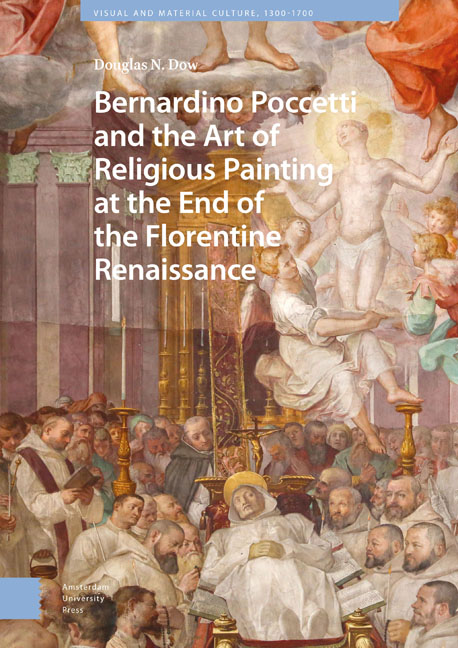Book contents
- Frontmatter
- Contents
- List of Illustrations
- List of Abbreviations
- Acknowledgments
- Introduction: ‘Il primo huomo da dipingere in fresco, che sia in questi paesi’: Bernardino Poccetti and the Historiography of Florentine Painting during the Late Renaissance
- 1 ‘Grandemente inclinato all’Arte del Disegno’: Filippo Baldinucci’s Biography of Bernardino Poccetti
- 2 ‘Le prime cose lodevoli molto’: Bernardino Poccetti’s Early Work and the Frescoes from the Life of Saint Dominic in the Chiostro Grande, Santa Maria Novella
- 3 ‘Locum ecclesiae designavit, quae Ioannis et uxoris pecunia extructa est’: Bernardino Poccetti and the Decoration of the Canigiani Chapel in Santa Felicita
- 4 ‘Miracula et alia id genus’: Bernardino Poccetti’s Frescoes in the Church of San Lorenzo at the Certosa del Galluzzo
- Color Plates
- 5 ‘L’inventore di dipingere tutte le muraglie della nostra chiesa’: Bernardino Poccetti and the Sixteenth-Century Decoration of Santa Maria del Carmine
- Conclusion
- Bibliography
- Index
1 - ‘Grandemente inclinato all’Arte del Disegno’: Filippo Baldinucci’s Biography of Bernardino Poccetti
Published online by Cambridge University Press: 13 February 2024
- Frontmatter
- Contents
- List of Illustrations
- List of Abbreviations
- Acknowledgments
- Introduction: ‘Il primo huomo da dipingere in fresco, che sia in questi paesi’: Bernardino Poccetti and the Historiography of Florentine Painting during the Late Renaissance
- 1 ‘Grandemente inclinato all’Arte del Disegno’: Filippo Baldinucci’s Biography of Bernardino Poccetti
- 2 ‘Le prime cose lodevoli molto’: Bernardino Poccetti’s Early Work and the Frescoes from the Life of Saint Dominic in the Chiostro Grande, Santa Maria Novella
- 3 ‘Locum ecclesiae designavit, quae Ioannis et uxoris pecunia extructa est’: Bernardino Poccetti and the Decoration of the Canigiani Chapel in Santa Felicita
- 4 ‘Miracula et alia id genus’: Bernardino Poccetti’s Frescoes in the Church of San Lorenzo at the Certosa del Galluzzo
- Color Plates
- 5 ‘L’inventore di dipingere tutte le muraglie della nostra chiesa’: Bernardino Poccetti and the Sixteenth-Century Decoration of Santa Maria del Carmine
- Conclusion
- Bibliography
- Index
Summary
Abstract: Filippo Baldinucci (1625–1696) wrote a detailed and compelling biography of Bernardino Barbatelli (called Poccetti, 1553–1612). This chapter situates Baldinucci and his work within contemporary discussions of art writing and its traditions, even as it reads the biography of Poccetti critically to understand the mechanics of Baldinucci's historical project. Baldinucci used longstanding tropes from art historical writing as well as more ‘modern’ approaches to history (archival research, interviews) and in Poccetti's biography these methods paint a detailed picture of the man, his personality, and his working habits. In addition, elements of Poccetti's biography serve Baldinucci's aim of elevating the Tuscan school of painting and updating Giorgio Vasari's collection of artists’ lives.
Keywords: Bernardino Barbatelli (called Poccetti); Filippo Baldinucci; Giorgio Vasari; historiography; biography
A young boy has been sent out to run an errand for his grandmother in his neighborhood on the south side of the Arno River in Florence. He is around eight or nine years old but he probably appears much younger thanks to his small stature—he was, after all, known throughout his life by the diminutive form of his name, Bernardino. The youth has taken this unsupervised moment wall of his parish church with a lump of charcoal, unaware that his admirable efforts and obvious skill have attracted the attention of one of Florence's more successful painters. This man, impressed by the youngster's natural ability and good judgment, decides that the boy would make an excellent apprentice and offers him an invitation to join his workshop. According to the biography written by Filippo Baldinucci (1625–1696) and published in the fourth volume of his Notizie de’ professori del disegno da Cimabue in qua in 1688 (Fig. 1.1), this is how Bernardo Barbatelli, now known as Bernardino Poccetti (1553–1612), came to his profession as an artist: through a serendipitous encounter with the painter Michele Tosini, also known as Michele di Ridolfo Ghirlandaio (1503–1577).
Baldinucci's Account of Poccetti's Discovery
It is not inconceivable that this story—although based on longstanding myths about artistic talent and discovery—might have at its core a kernel of truth, since much of it aligns with what is known about the childhood of Poccetti, who was born in San Gimignano in 1553 to Bartolomeo Barbatelli and his wife, Lucia.
- Type
- Chapter
- Information
- Bernardino Poccetti and the Art of Religious Painting at the End of the Florentine Renaissance , pp. 43 - 78Publisher: Amsterdam University PressPrint publication year: 2023

